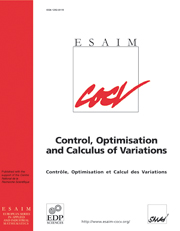Article contents
An Extension of the Auxiliary Problem Principle to Nonsymmetric Auxiliary Operators
Published online by Cambridge University Press: 15 August 2002
Abstract
To find a zero of a maximal monotone operator, an extension of the Auxiliary Problem Principle to nonsymmetric auxiliary operators is proposed. The main convergence result supposes a relationship between the main operator and the nonsymmetric component of the auxiliary operator. When applied to the particular case of convex-concave functions, this result implies the convergence of the parallel version of the Arrow-Hurwicz algorithm under the assumptions of Lipschitz and partial Dunn properties of the main operator. The latter is systematically enforced by partial regularization. In the strongly monotone case, it is shown that the convergence is linear in the average. Moreover, if the symmetric part of the auxiliary operator is linear, the Lipschitz property of the inverse suffices to ensure a linear convergence rate in the average.
- Type
- Research Article
- Information
- Copyright
- © EDP Sciences, SMAI, 1997
- 7
- Cited by




